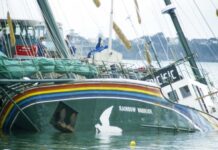Our apologies for an error in pagination this week – It’s not often our printers get it wrong!
Waiheke bird lover Sue Fitchett is encouraging people to offer water and food for native birds during long periods of dry weather.
Placing large water containers around gardens and hanging in trees allows birds to wash and drink, she says.
Shallow containers of water can be set out for insects, such as weta and lizards.
“These containers need to be cleaned out and refilled every few days to stop the spread of disease among species,” says Sue.
Kereru sometimes come down to low water sources, such as birdbaths, but a full roof gutter can also provide a safe drinking spot for the big wood pigeons.
Birds that eat insects, such as riroriro (grey warblers) and piwakawaka (fantails), can also suffer as insects become scarcer in dry periods.
People can help insectivorous birds and lizards by attracting fruit flies and insects to compost piles or caches of fruit.
Lizards will eat mashed banana mixed with honey, which can be spooned into bottle tops and placed in tracking tunnels, under corrugated iron, or up trees.
Hanging water containers with sugar water will help white eyes and tui during droughts.
Sue recommends mixing half a cup of sugar with a litre of water during the summer, but using less sugar when food for birds becomes plentiful as native berries ripen.
While some people don’t recommend feeding introduced birds, Sue says they can also struggle to find food during a long, dry summer.
Sparrows and chaffinches will gobble seed mixes and blackbirds can be fed with a few handfuls of cat biscuits a day.
“White-eyes and blackbirds, also, will peck at half peeled apples stuck to a sharp branch end,” says Sue.
• Rose Davis







